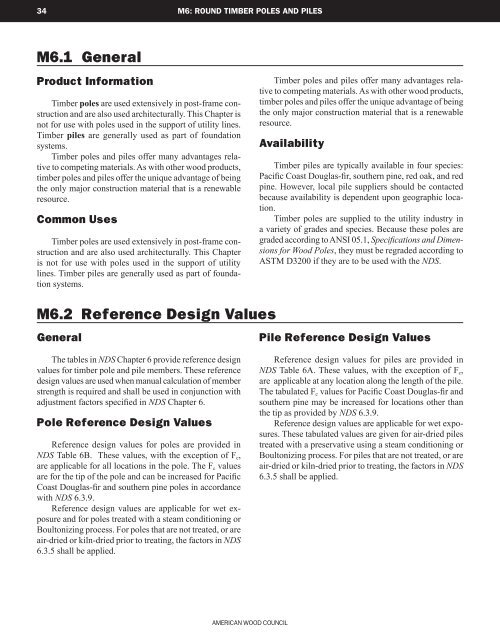ASD/LRFD Manual - American Wood Council
ASD/LRFD Manual - American Wood Council
ASD/LRFD Manual - American Wood Council
Create successful ePaper yourself
Turn your PDF publications into a flip-book with our unique Google optimized e-Paper software.
34 M6: ROUND TIMBER POLES AND PILES<br />
M6.1 General<br />
Product Information<br />
Timber poles are used extensively in post-frame construction<br />
and are also used architecturally. This Chapter is<br />
not for use with poles used in the support of utility lines.<br />
Timber piles are generally used as part of foundation<br />
systems.<br />
Timber poles and piles offer many advantages relative<br />
to competing materials. As with other wood products,<br />
timber poles and piles offer the unique advantage of being<br />
the only major construction material that is a renewable<br />
resource.<br />
Common Uses<br />
Timber poles are used extensively in post-frame construction<br />
and are also used architecturally. This Chapter<br />
is not for use with poles used in the support of utility<br />
lines. Timber piles are generally used as part of foundation<br />
systems.<br />
Timber poles and piles offer many advantages relative<br />
to competing materials. As with other wood products,<br />
timber poles and piles offer the unique advantage of being<br />
the only major construction material that is a renewable<br />
resource.<br />
Availability<br />
Timber piles are typically available in four species:<br />
Pacific Coast Douglas-fir, southern pine, red oak, and red<br />
pine. However, local pile suppliers should be contacted<br />
because availability is dependent upon geographic location.<br />
Timber poles are supplied to the utility industry in<br />
a variety of grades and species. Because these poles are<br />
graded according to ANSI 05.1, Specifications and Dimensions<br />
for <strong>Wood</strong> Poles, they must be regraded according to<br />
ASTM D3200 if they are to be used with the NDS.<br />
M6.2 Reference Design Values<br />
General<br />
The tables in NDS Chapter 6 provide reference design<br />
values for timber pole and pile members. These reference<br />
design values are used when manual calculation of member<br />
strength is required and shall be used in conjunction with<br />
adjustment factors specified in NDS Chapter 6.<br />
Pole Reference Design Values<br />
Reference design values for poles are provided in<br />
NDS Table 6B. These values, with the exception of F c ,<br />
are applicable for all locations in the pole. The F c values<br />
are for the tip of the pole and can be increased for Pacific<br />
Coast Douglas-fir and southern pine poles in accordance<br />
with NDS 6.3.9.<br />
Reference design values are applicable for wet exposure<br />
and for poles treated with a steam conditioning or<br />
Boultonizing process. For poles that are not treated, or are<br />
air-dried or kiln-dried prior to treating, the factors in NDS<br />
6.3.5 shall be applied.<br />
Pile Reference Design Values<br />
Reference design values for piles are provided in<br />
NDS Table 6A. These values, with the exception of F c ,<br />
are applicable at any location along the length of the pile.<br />
The tabulated F c values for Pacific Coast Douglas-fir and<br />
southern pine may be increased for locations other than<br />
the tip as provided by NDS 6.3.9.<br />
Reference design values are applicable for wet exposures.<br />
These tabulated values are given for air-dried piles<br />
treated with a preservative using a steam conditioning or<br />
Boultonizing process. For piles that are not treated, or are<br />
air-dried or kiln-dried prior to treating, the factors in NDS<br />
6.3.5 shall be applied.<br />
<strong>American</strong> <strong>Wood</strong> <strong>Council</strong>

















